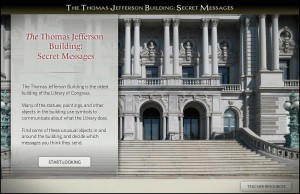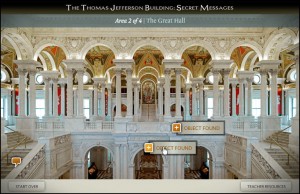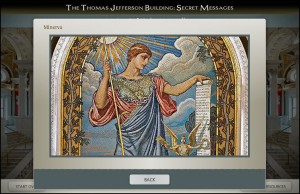Information literacy standards today often require students to determine the meaning of symbols. They also ask students to think about creator’s purpose. The Thomas Jefferson Building: Secret Messages is an online activity designed by the Library of Congress that allows students to do both.
In this interactive, self-paced activity, students explore the Library’s historic Thomas Jefferson Building, which was built in 1897 in the style of the Italian Renaissance and features symbolic sculptural and painted decoration by more than 50 American artists. The Jefferson Building celebrates knowledge and symbolizes American turn-of-the-century optimism. Its elaborate decorations are worth a close look, since few buildings represent human thought and aspiration so dramatically. The Thomas Jefferson Building: Secret Messages guides students in discovering and examining these symbolic decorations in and around the building – thinking critically about what secret messages these objects might send about the Library’s purpose.
Teaching ideas:
- Have students complete the online activity in small groups to find objects and collaboratively interpret what messages they send. Tip: As each object is discovered, an activity window will open; encourage students to click on the thumbnail image for a close-up view.
- Use one or more objects in this activity in a primary source analysis, to help students become more familiar with architectural elements and how they are used to communicate. Use the primary source analysis tool and ask guiding questions such as:
Why do you think this object was created for the Thomas Jefferson Building?
Who do you think was the intended audience for this object?
What feelings or ideas do you think its creators wanted to communicate? - Use this activity to help build student understanding about symbolism in the United States at the end of the nineteenth century.
- Use this as a pre-visit activity if you are planning to bring your students to the Library.
Additional resources can be found in the Teacher Resources section of this activity.
We’d love to hear your experiences using Library resources to explore creator’s purpose or symbolism.



